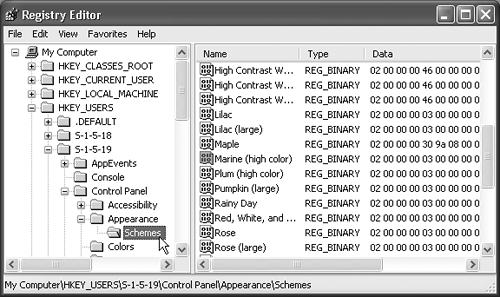16.10 The Registry
| Here and there, in books, articles, and conversations, you'll hear hushed references to something called the Windows Registry ” usually accompanied by either knowing or bewildered glances. Microsoft would just as soon you not even know about the Registry. There's not a word about it in the basic user guides, and the only information you'll find about it in the Help and Support center says, "It is strongly recommended that you do not edit Registry settings yourself. Incorrectly editing the Registry may severely damage your system." If you're curious , however, read on. The Registry is your PC's master database of preference settings, most of which are extremely technical. It keeps track of every program you install, every Plug and Play device you add, every multiple-user profile you create (Chapter 17), your networking configuration, and much more. If you've noticed that shortcut menus and Properties dialog boxes look different depending on what you're clicking, you have the Registry to thank. It knows what you're clicking and what options should appear as a result. As you can well imagine, therefore, the Registry (Figure 16-17) is an extremely important cog in the Windows XP machine. That's why Windows marks your Registry files as invisible and non-deletable, and why it makes a Registry backup every single day. If the Registry gets damaged or randomly edited, a grisly plague of problems may descend upon your machine. Windows XP's System Restore feature (described in this chapter) can extract you from such a mess, but at least you now know why the Registry is rarely even mentioned to novices. Figure 16-17. The Registry's settings are organized hierarchically; RegEdit looks a lot like Windows Explorer. But there's no way to figure out which part of the Registry holds a particular setting or performs a particular function. It's like flying a plane that has no windows.
Still, the Registry is worth learning about. You shouldn't edit it arbitrarily, but if you get a step-by-step "recipe" from a book, magazine, Web site, or technical-help agent, you shouldn't fear opening the Registry to make a few changes. You can do so using a program called RegEdit, which appears when you choose Start You'll discover that the Registry uses cryptic abbreviations to describe the operating system's various components and settings. (You're generally shielded from all of this geekiness by friendlier front ends. For example, most of the programs in the Control Panel are nothing more than dialog boxes that modify settings in the Registry.) If you think you're ready to dip into the programmery netherworld of Registry editing, a world of recipes awaits you on the Web. You might start with http://www.regedit.com and http://www. winreg .com, which provide dozens of useful tips and tricks for making your PC world a better place via Registry adjustments. NOTE In the market for a cool-looking diagnostic tool that gives you the geeky rush of the Registry without any of the danger? Press Ctrl+Alt+Delete to open the Task Manager dialog box, and then click the Performance tab. These yellow-on-black graphs update themselves in real time, looking something like a lie detector's output ”except that these peaks and valleys represent the efforts of your processor and virtual-memory manager. As you go about your work, opening programs, editing documents, and so on, you'll see these graphs respond to the load on your system. (Close it when you're finished marveling, though, so the graph doesn't slow down your PC.) |
EAN: 2147483647
Pages: 230
 Run, type
Run, type